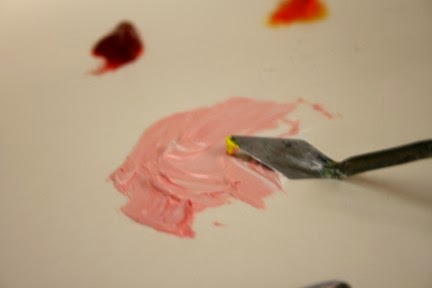We got a new small freezer for the basement. I love it! Compact and just enough room for two older people. Our large upright gave up the ghost years ago, and being empty nesters, we really no longer needed the big freezer anyway. Funny how not having a teenage boy in the house reduces the grocery bills!
Now you are wondering what is all this talk about a freezer
doing in an art blog? Yes, its nice she has one, but why do I care?
One of the things I did miss about loosing the large freezer
in the dungeon is the lost of pallet storage. Yes, pallet storage. Not on the
top of the freezer but in it.
I paint with oils. Often in the past, I had little time to
paint. (that full-time job really got in the way of my play time!) One of the
best ways to preserve an oil pallet when you know you will be away from it for
a while is to freeze it. Freezing does not harm good quality oil paints. This
is really helpful if you need to be away from painting for a long period and
you want to preserve that special mixed color. Put a sheet of wax paper over
the pallet (or another sheet if you use disposable paper pallets) push the
excess air out and pop it in the freezer. I used to reserve the top shelf of
the large freezer for this.
Now that I am retired from secular work, I usually can get
back to a canvas in a reasonable amount of time, and with big projects I have
taken to using a pallet box with a sealable lid. I line it with either freezer
paper or a disposable pallet sheet. This will keep the paint workable for a
couple of days, which is usually all I need. If I paint on Tuesday night, I
know I will not be able to get back to it before Friday. I will mound up any
paint on the pallet, and seal the lid. (these boxes are also available for acrylics and have a large sheet sponge.)
Often, however, I use a Styrofoam tray for a pallet.
The kind that you get from the meat department. When I come home from the
store, I always repackage the meat. That plastic they wrap the meat in is not
good for it or you. Then if the tray is a good size, I will wash it with soap and
water and let it dry. It goes down into the dungeon to be re-used as a pallet.
You can clean and re-use it several time. You cannot use it for gesso however.
Gesso eats it. I use the Styrofoam trays as a cheap portable pallet. It saves
money I can dearly use for other art supplies.
I will go cheap for the furnishing and accessories for the
studio. I find garage sales and thrift stores a good source of furnishings. Whenever I buy things, I look at the packaging and think, can I reuse
this? Most of my dungeon accoutrements are recycled packaging, garage sale
fines or even things I dumpster dived for.
But not for real art supplies.
I don’t go cheap for what I use to create artwork on or
with. Experience has taught me that this is false economy. I will not use
low-grade paint, pencils or support. I don’t use hardware store mineral
spirits. I have culled cheap brushes. Supports must be high quality. But for my
pallet? I will recycle. For large paintings I often use a sheet of freezer
paper taped to the craft table I got when a local school threw it out in favor
of the new plastic tables. It is a heavy Formica covered table that nothing can
hurt. I love it. It weights a ton, but I can do just about anything on it. I
can tape down the sheet of freezer paper, and when I am done, simply scrub it
off. Nothing sticks. Also, nothing hurts it. I have a lazy-susan on this table that I put my mediums
on. I can always find what I need. You know those plastic trays that they sell
for holding utensils? They are touted for caring silverware out to picnic
tables. I picked up several at garage sales ( I guess they really don’t work
well for this, you see them all the time) well, great way to keep brushes
sorted.
I used those tin boxes that breath mints come in for kneaded
erasers. I am sure you all can think of tons of things to do with those little boxes.
One of the best ways to carry my long brushes is in one of
those cardboard wine bottle tubes. they are sold to carry a bottle of wine as a hostess gift. They are sturdy and have a nice handle. And they will hold your longest brushes.
So I am happy to have a freezer again in the dungeon.
Someplace to stash that pallet between painting sessions.


















































